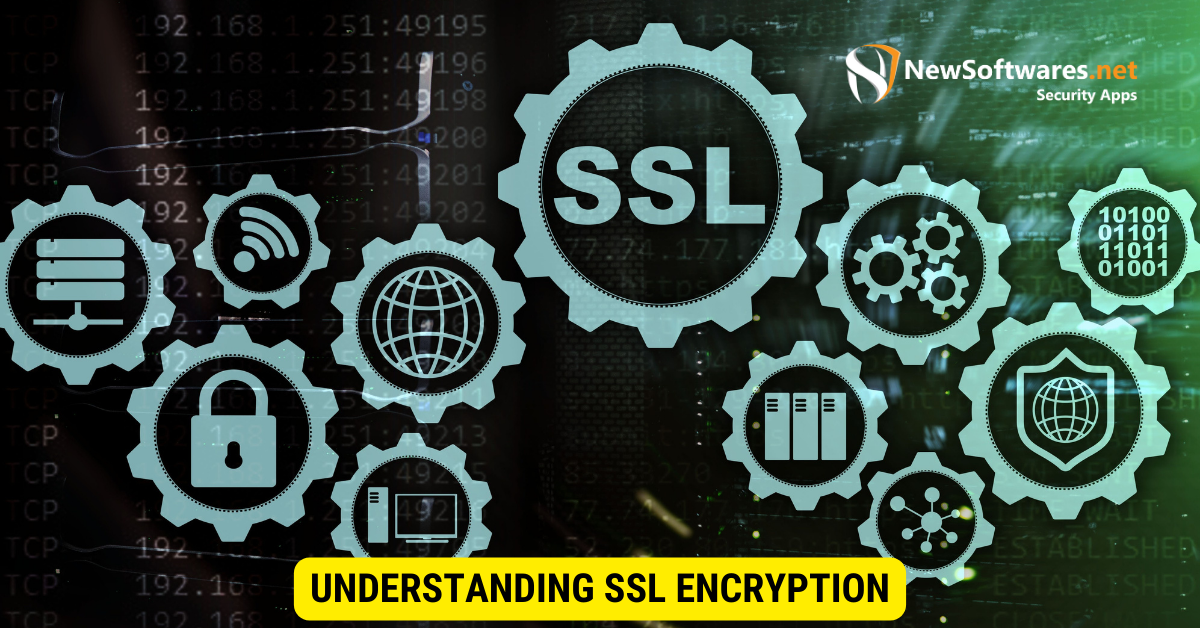Data sent from a server to a client is encrypted using SSL (Secure Sockets Layer). SSL estaeyes and potential cyber threats givesblishes a secure and encrypted connection between a client and a server, safeguarding any data transmitted between the entities.
In today’s digital age, the security and privacy of data transmission have become paramount concerns. As more sensitive information is being exchanged over the Internet, protecting this data from unauthorized access is essential. One technology that plays a vital character in safeguarding data during transmission is SSL encryption.
Understanding SSL Encryption

SSL (Secure Sockets Layer) encryption is a standard security technology to launch a secure and encrypted connection among a client (such as a web browser) and a server. It encrypts the data sent between these two parties, making it unreadable to anyone who intercepts it.
SSL encryption plays a crucial role in ensuring the confidentiality and integrity of data during transmission. It acts as a shield, protecting sensitive info such as credit card details, usernames, passwords, and personal information from falling into the wrong hands. By encrypting the data, SSL ensures that it remains unintelligible and useless to malicious individuals even if it is intercepted.
The Role of SSL in Data Transmission
The primary purpose of SSL encryption is to defend the confidentiality and integrity of data during transmission. It ensures that malicious individuals cannot intercept or tamper with sensitive information. This is particularly important when transmitting data over unsecured networks, such as public Wi-Fi hotspots or shared networks.
Imagine sitting in a coffee shop, enjoying your favorite beverage while browsing the Internet. You make an online purchase, entering your credit card details into the website’s payment form. Without SSL encryption, this information would be transmitted in plain text, vulnerable to interception by anyone with malicious intent. However, SSL encryption transforms your credit card details into an unreadable jumble of characters, rendering them useless to anyone attempting to intercept them.
How SSL Encryption Works?
When a operator connects to a server using SSL encryption, both parties use a series of steps to establish a secure connection. This process involves the exchange of digital certificates, which verify the authenticity of the server and the client. These certificates are issued by trusted third-party administrations known as Certificate Authorities (CAs).
Let’s dive deeper into the process of establishing a secure SSL connection. When a client initiates a joining with a server, the server responds by sending its digital certificate to the client. This certificate contains the server’s public key, which is used for encryption and decryption. The client then verifies the certificate’s authenticity by checking its validity and the CA that issued it. The client proceeds with the connection if the certificate is valid and trusted.
Once the connection is established, SSL encryption comes into play. It encrypts the data using complex mathematical algorithms, making it virtually impossible for illegal parties to decipher. This encryption process involves converting the plain text data into ciphertext, which can only be decrypted using the corresponding private key held by the intended recipient.
SSL encryption is a secret code only the intended recipient can understand. It takes the data you send, scrambles it using complex mathematical operations, and transforms it into an unreadable format. Only the recipient, possessing the correct private key, can decrypt the data and convert it to its original form.
Using SSL encryption, websites, and online services can provide a secure environment for their users, ensuring their sensitive information remains protected. Knowing that their data is shielded from prying eyes and potential cyber threats gives users peace of mind.
The Journey of Data from Server to Client

Before delving into the specifics of SSL encryption, it is vital to understand the potential dangers involved in data transmission without it.
Data transmission plays a crucial role in the world of technology. Whether browsing the web, sending emails, or making online transactions, data is constantly exchanged between servers and clients. However, this exchange of information is not without its vulnerabilities.
Data Transmission without SSL
Without SSL encryption, data transmitted between a server and a client is vulnerable to interception by hackers. Imagine a scenario where you’re browsing a website and entering your personal information, such as your name, address, and credit card details. Without SSL, this data is transmitted in plain text, making it easy for malicious individuals to intercept and exploit.
These hackers can employ various techniques to intercept your data, such as eavesdropping on your network connection or performing a man-in-the-middle attack. The consequences can be severe once they have access to your sensitive information. Some potential risks are identity theft, financial fraud, and unauthorized access to confidential data.
Data Transmission with SSL
On the other hand, data transmission with SSL encryption ensures that all communication between the server and the client is secure and private. SSL, which stands for Secure Sockets Layer, is a cryptographic protocol that establishes an encrypted link between the server and the client.
When SSL is implemented, the transmitted data is encrypted before it leaves the server. This means that even if a hacker manages to intercept the data, they won’t be able to decipher its contents. The encrypted data is then decrypted by the client using a unique key, ensuring that only the intended recipient can access the information.
SSL encryption provides several layers of protection. Firstly, it ensures the confidentiality of sensitive information by encrypting it during transmission. Secondly, it verifies the server’s authenticity, preventing attackers from impersonating legitimate websites. Lastly, SSL provides integrity, ensuring the data remains unchanged during transmission.
Implementing SSL encryption is crucial for any website that handles sensitive information. It not only protects the privacy of users but also helps build trust and credibility. When users see the padlock icon or the “https” in the URL, they know that their data is being transmitted securely.
In conclusion, data transmission without SSL encryption poses significant risks to individuals and businesses. By implementing SSL, organizations can ensure the security and privacy of their users’ data, mitigating the potential for unauthorized access and data breaches.
The Importance of SSL Encryption
SSL encryption is crucial for various reasons, from protecting sensitive information to enhancing trust and credibility.
As technology advances, the need for secure communication over the Internet becomes increasingly important. SSL encryption, or Secure Sockets Layer encryption, is vital in ensuring that sensitive information remains confidential and secure.
Protecting Sensitive Information
One of the primary reasons for using SSL encryption is to protect sensitive information from falling into the wrong hands. Whether credit card details during an online transaction or personal data entered on a website, SSL encryption ensures that this information is kept safe from interception and misuse.
Imagine a scenario where you purchase a product online and must enter your credit card info. Without SSL encryption, hackers could easily intercept this data, exposing you to the risk of identity theft and financial loss. However, with SSL encryption, your credit card details are encrypted, making it virtually incredible for anyone to decipher the information.
Furthermore, SSL encryption also prevents unauthorized access to sensitive information. It establishes a secure connection between the user’s browser and the website, ensuring that any data transmitted between them remains confidential. This is especially crucial for websites that handle complex data, such as healthcare providers, financial institutions, and e-commerce platforms.
Enhancing Trust and Credibility
When users visit a website secured with SSL encryption, they can see visual cues, such as a padlock icon, representing that the connection is secure. This not only gives users peace of mind but also enhances the credibility and trustworthiness of the website.
Trust is a fundamental aspect of any online interaction. Users are likelier to engage with a website they perceive as secure and trustworthy. By implementing SSL encryption, website owners can demonstrate their commitment to protecting user data building trust and credibility with their audience.
Moreover, SSL encryption significantly affects search engine optimization (SEO), which is crucial for online visibility. Major search engines such as Google give preference to websites that prioritize security, seeking to offer users the finest browsing experience. Using SSL encryption, websites can enhance their search engine rankings, resulting in greater visibility and a boost in organic traffic.
In conclusion, SSL encryption is not just a technical requirement but essential to maintaining a secure and trustworthy online presence. It safeguards sensitive information, protects against unauthorized access, and enhances user trust and credibility. As the digital landscape evolves, implementing SSL encryption should be a top priority for website owners and online businesses.
SSL Encryption and Different Types of Data
The use of SSL encryption is not limited to specific types of data. It can protect both text data and multimedia data.
Text Data and SSL Encryption
Text data, such as login credentials, email messages, and form submissions, can contain sensitive information that needs to be protected. SSL encryption ensures that this data remains confidential during transmission, preventing it from being intercepted or tampered with.
Multimedia Data and SSL Encryption
With the increasing popularity of multimedia content, SSL encryption also plays a crucial role in protecting the privacy of multimedia data. Whether it’s images, videos, or audio files, SSL encryption ensures that these files are transmitted securely and cannot be accessed or altered by unauthorized individuals.
Common Misconceptions about SSL Encryption
Although SSL encryption offers robust security and protection, some misconceptions surround its usage.
SSL Encryption and Internet Speed

Some people believe that using SSL encryption can slow down internet speed. While it is true that SSL encryption requires additional processing power, advancements in technology have significantly reduced any noticeable impact on internet speed.
The Cost of SSL Encryption
Another misconception is that SSL encryption is expensive, making it inaccessible to smaller websites or businesses. However, with affordable SSL certificates and options like Let’s Encrypt, implementing SSL encryption has become more accessible and cost-effective.
FAQs
What is the primary purpose of SSL encryption?
The primary purpose of SSL encryption is to protect the confidentiality and integrity of data in transmission between a server and a client.
How does SSL encryption work?
Using encryption algorithms, SSL encryption works by converting the data into an unreadable format. It involves exchanging digital certificates to authenticate the server and the client, ensuring a secure connection.
What kind of data can SSL encrypt?
SSL can encrypt text data, such as login credentials and email messages, and multimedia data, like images, videos, and audio files.
Does using SSL encryption affect internet speed?
While SSL encryption requires additional processing, modern technology advancements have minimized its impact on internet speed.
Is SSL encryption expensive to implement?
While initial costs were associated with SSL encryption, the emergence of affordable SSL certificates and free options like Let’s Encrypt have made it more accessible to all.
Key Takeaways
- SSL encryption ensures a secure connection between a server and a client.
- During transmission, it protects sensitive data, such as login credentials, credit card details, and personal info.
- SSL enhances user trust and credibility, indicated by graphic cues like the padlock icon in the browser.
- Misconceptions about SSL include potentially slowed internet speeds and high implementation costs.
- With the rise of affordable and free SSL certificate options, encryption has become more accessible to smaller websites and businesses.
Conclusion
Regarding data transmission over the Internet, SSL encryption provides a critical layer of security. It confirms that sensitive information remains confidential and protected from unauthorized access. Individuals and organizations can make informed choices to secure their data and enhance their online presence by understanding the role, importance, and misconceptions surrounding SSL encryption.
